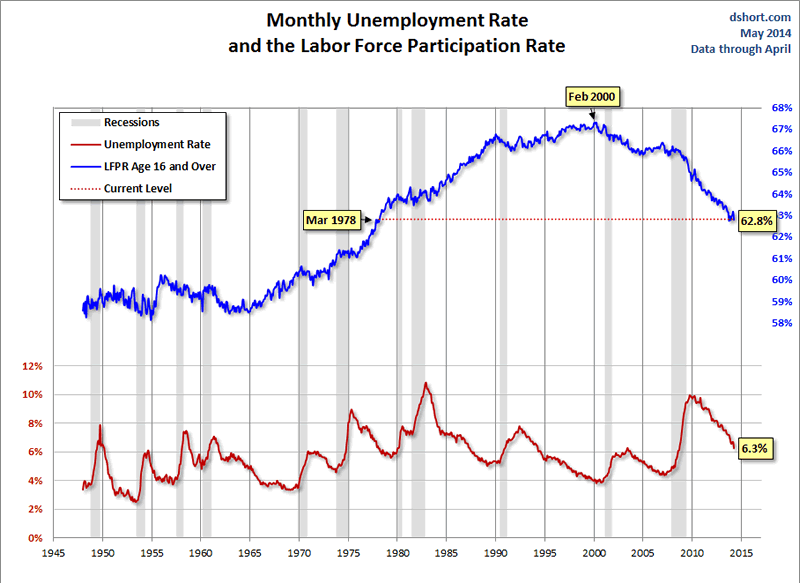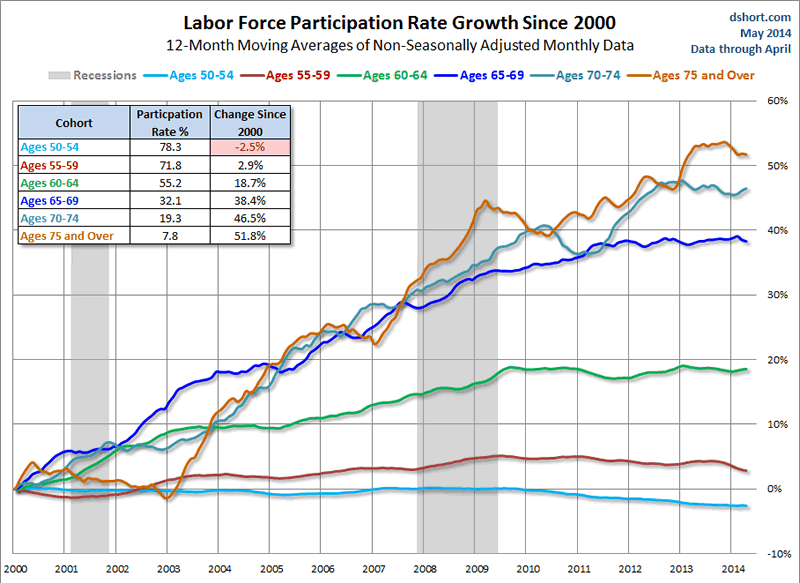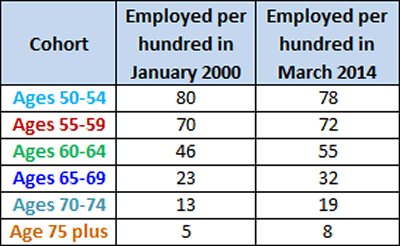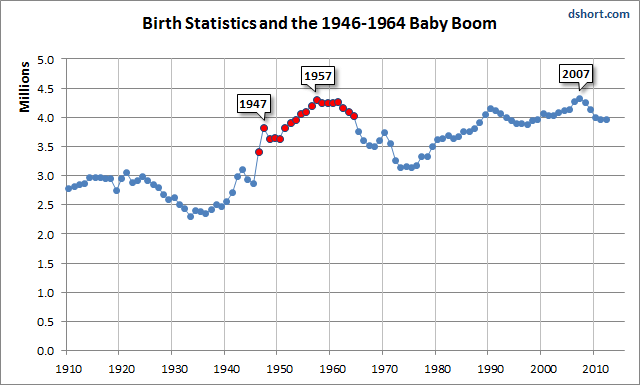Demographic Trends in the 50-and-Older Work Force
Economics / Demographics May 06, 2014 - 10:11 AM GMTBy: PhilStockWorld
 Courtesy of Doug Short: In my earlier update on demographic trends in employment, I included a chart illustrating the growth (or shrinkage) in six age cohorts since the turn of the century. In this commentary we’ll zoom in on the age 50 and older Labor Force Participation Rate (LFPR).
Courtesy of Doug Short: In my earlier update on demographic trends in employment, I included a chart illustrating the growth (or shrinkage) in six age cohorts since the turn of the century. In this commentary we’ll zoom in on the age 50 and older Labor Force Participation Rate (LFPR).
But first, let’s review the big picture. The overall LFPR is a simple computation: You take the Civilian Labor Force (people age 16 and over employed or seeking employment) and divide it by the Civilian Noninstitutional Population (those 16 and over not in the military and or committed to an institution). The result is the participation rate expressed as a percent.
For the larger context, here is a snapshot of the monthly LFPR for age 16 and over stretching back to the Bureau of Labor Statistics’ starting point in 1948, the blue line in the chart below, along with the unemployment rate.

The overall LFPR peaked in February 2000 at 67.3% and gradually began falling. The rate leveled out from 2004 to 2007, but in 2008, with onset of the Great Recession, the rate began to accelerate. The latest rate is 63.0%, back to a level first seen in 1978. The demography of our aging workforce has been a major contributor to this trend. The oldest Baby Boomers, those born between 1946 and 1964, began becoming eligible for reduced Social Security benefits in 2008 and full benefits in 2012. Job cuts during the Great Recession certainly strengthened the trend.
The Growing Ratios of Older Workers
It might seem intuitive that the participation rate for the older workers would have declined the fastest. But exactly the opposite has been the case. The chart below illustrates the growth of the LFPR for six age 50-plus cohorts since the turn of the century. I’ve divided them into five-year cohorts from ages 50 through 74 and an open-ended age 75 and older. The pattern is clear: The older the cohort, the greater the growth.

Another Way to Envision the Data
The table inset in the chart above shows the participation rate for the latest month and the percentage growth since January 2000. The adjacent table rounds the rates to integers for January 2000 and for the latest month. Essentially this table gives us two snapshots: The number of workers per hundred for each of the six cohorts at the turn of the century and the number of workers per hundred now. This is not the scenario that would have been envisioned a generation ago for the “Golden Years” of retirement. Consider: Today nearly one in three of the 65-69 cohort and almost one in five of the 70-74 cohort are in the labor force.

There is no question that the pace of Boomer retirement will accelerate in the years ahead. Just add about 65 years to the red dots in the chart below and you’ll get some idea of the epic retirement wave that is just beginning (and note that the birth statistics below don’t include immigration).

What’s Ahead?
With the improvement in the market since the 2009 index lows, many households approaching the traditional retirement age are in better financial shape and with healthier nest eggs than was the case a few years ago. On the other hand, when we look at the age 65-69 cohort, the dark blue line in the second chart above, we see that it rose steadily between the last two recessions despite the market’s improvement, although it appears to be leveling out over the past 18 or so months. If we can avoid a near-term recession and the economy continues to improve, perhaps the participation rates of the older cohorts will gradually reverse directions. That would certainly improve the job opportunities of younger generations.
- Phil
Philip R. Davis is a founder of Phil's Stock World (www.philstockworld.com), a stock and options trading site that teaches the art of options trading to newcomers and devises advanced strategies for expert traders. Mr. Davis is a serial entrepreneur, having founded software company Accu-Title, a real estate title insurance software solution, and is also the President of the Delphi Consulting Corp., an M&A consulting firm that helps large and small companies obtain funding and close deals. He was also the founder of Accu-Search, a property data corporation that was sold to DataTrace in 2004 and Personality Plus, a precursor to eHarmony.com. Phil was a former editor of a UMass/Amherst humor magazine and it shows in his writing -- which is filled with colorful commentary along with very specific ideas on stock option purchases (Phil rarely holds actual stocks). Visit: Phil's Stock World (www.philstockworld.com)
© 2014 Copyright PhilStockWorld - All Rights Reserved Disclaimer: The above is a matter of opinion provided for general information purposes only and is not intended as investment advice. Information and analysis above are derived from sources and utilising methods believed to be reliable, but we cannot accept responsibility for any losses you may incur as a result of this analysis. Individuals should consult with their personal financial advisors.
PhilStockWorld Archive |
© 2005-2022 http://www.MarketOracle.co.uk - The Market Oracle is a FREE Daily Financial Markets Analysis & Forecasting online publication.



